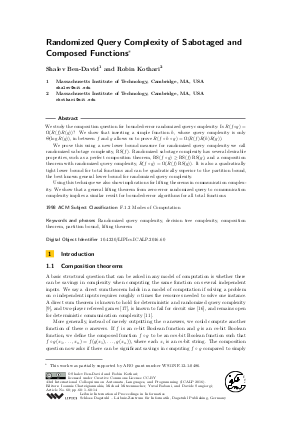Randomized Query Complexity of Sabotaged and Composed Functions
Authors Ben-David Shalev, Robin Kothari
-
Part of:
Volume:
43rd International Colloquium on Automata, Languages, and Programming (ICALP 2016)
Part of: Series: Leibniz International Proceedings in Informatics (LIPIcs)
Part of: Conference: International Colloquium on Automata, Languages, and Programming (ICALP) - License:
 Creative Commons Attribution 3.0 Unported license
Creative Commons Attribution 3.0 Unported license
- Publication Date: 2016-08-23
File

PDF
LIPIcs.ICALP.2016.60.pdf
- Filesize: 490 kB
- 14 pages
Document Identifiers
Subject Classification
Keywords
- Randomized query complexity
- decision tree complexity
- composition theorem
- partition bound
- lifting theorem
Metrics
- Access Statistics
-
Total Accesses (updated on a weekly basis)
0PDF Downloads0Metadata Views
Abstract
We study the composition question for bounded-error randomized query complexity: Is R(f circ g) = Omega(R(f)R(g))? We show that inserting a simple function h, whose query complexity is onlyTheta(log R(g)), in between f and g allows us to prove R(f circ h circ g) = Omega(R(f)R(h)R(g)). We prove this using a new lower bound measure for randomized query complexity we call randomized sabotage complexity, RS(f). Randomized sabotage complexity has several desirable properties, such as a perfect composition theorem, RS(f circ g) >= RS(f) RS(g), and a composition theorem with randomized query complexity, R(f circ g) = Omega(R(f) RS(g)). It is also a quadratically tight lower bound for total functions and can be quadratically superior to the partition bound, the best known general lower bound for randomized query complexity. Using this technique we also show implications for lifting theorems in communication complexity. We show that a general lifting theorem from zero-error randomized query to communication complexity implies a similar result for bounded-error algorithms for all total functions.
Cite As Get BibTex
Ben-David Shalev and Robin Kothari. Randomized Query Complexity of Sabotaged and Composed Functions. In 43rd International Colloquium on Automata, Languages, and Programming (ICALP 2016). Leibniz International Proceedings in Informatics (LIPIcs), Volume 55, pp. 60:1-60:14, Schloss Dagstuhl – Leibniz-Zentrum für Informatik (2016)
https://doi.org/10.4230/LIPIcs.ICALP.2016.60
BibTex
@InProceedings{shalev_et_al:LIPIcs.ICALP.2016.60,
author = {Shalev, Ben-David and Kothari, Robin},
title = {{Randomized Query Complexity of Sabotaged and Composed Functions}},
booktitle = {43rd International Colloquium on Automata, Languages, and Programming (ICALP 2016)},
pages = {60:1--60:14},
series = {Leibniz International Proceedings in Informatics (LIPIcs)},
ISBN = {978-3-95977-013-2},
ISSN = {1868-8969},
year = {2016},
volume = {55},
editor = {Chatzigiannakis, Ioannis and Mitzenmacher, Michael and Rabani, Yuval and Sangiorgi, Davide},
publisher = {Schloss Dagstuhl -- Leibniz-Zentrum f{\"u}r Informatik},
address = {Dagstuhl, Germany},
URL = {https://drops.dagstuhl.de/entities/document/10.4230/LIPIcs.ICALP.2016.60},
URN = {urn:nbn:de:0030-drops-62233},
doi = {10.4230/LIPIcs.ICALP.2016.60},
annote = {Keywords: Randomized query complexity, decision tree complexity, composition theorem, partition bound, lifting theorem}
}
Author Details
References
-
Scott Aaronson, Shalev Ben-David, and Robin Kothari. Separations in query complexity using cheat sheets. To appear in Proceedings of STOC 2016. arXiv preprint http://arxiv.org/abs/arXiv:1511.01937, 2015.

-
Andris Ambainis, Martins Kokainis, and Robin Kothari. Nearly optimal separations between communication (or query) complexity and partitions. To appear in Proceedings of CCC 2016. arXiv preprints http://arxiv.org/abs/arXiv:1512.00661 and http://arxiv.org/abs/arXiv:1512.01210, 2015.

- Harry Buhrman and Ronald de Wolf. Complexity measures and decision tree complexity: a survey. Theoretical Computer Science, 288(1):21-43, 2002. URL: http://dx.doi.org/10.1016/S0304-3975(01)00144-X.
- Andrew Drucker. Improved direct product theorems for randomized query complexity. Computational Complexity, 21(2):197-244, 2012. URL: http://dx.doi.org/10.1007/s00037-012-0043-7.
- Mika Göös, T.S. Jayram, Toniann Pitassi, and Thomas Watson. Randomized communication vs. partition number. Electronic Colloquium on Computational Complexity (ECCC) http://eccc.hpi-web.de/report/2015/169/, 2015.
- Mika Göös, Toniann Pitassi, and Thomas Watson. Deterministic communication vs. partition number. In Foundations of Computer Science (FOCS), 2015 IEEE 56th Annual Symposium on, pages 1077-1088, Oct 2015. URL: http://dx.doi.org/10.1109/FOCS.2015.70.
- Peter Høyer, Troy Lee, and Robert Špalek. Negative weights make adversaries stronger. In Proceedings of the 39th ACM Symposium on Theory of Computing (STOC 2007), pages 526-535, 2007. URL: http://dx.doi.org/10.1145/1250790.1250867.
- Rahul Jain and Hartmut Klauck. The partition bound for classical communication complexity and query complexity. In Proceedings of the 2010 IEEE 25th Annual Conference on Computational Complexity, CCC'10, pages 247-258, 2010. URL: http://dx.doi.org/10.1109/CCC.2010.31.
- Rahul Jain, Hartmut Klauck, and Miklos Santha. Optimal direct sum results for deterministic and randomized decision tree complexity. Information Processing Letters, 110(20):893-897, 2010. URL: http://dx.doi.org/10.1016/j.ipl.2010.07.020.
-
Rahul Jain, Troy Lee, and Nisheeth K. Vishnoi. A quadratically tight partition bound for classical communication complexity and query complexity. arXiv preprint http://arxiv.org/abs/arXiv:1401.4512, 2014.

- Mauricio Karchmer, Ran Raz, and Avi Wigderson. Super-logarithmic depth lower bounds via the direct sum in communication complexity. Computational Complexity, 5(3-4):191-204, 1995. URL: http://dx.doi.org/10.1007/BF01206317.
- Shelby Kimmel. Quantum adversary (upper) bound. In Automata, Languages, and Programming, volume 7391 of Lecture Notes in Computer Science, pages 557-568, 2012. URL: http://dx.doi.org/10.1007/978-3-642-31594-7_47.
- Raghav Kulkarni and Avishay Tal. On fractional block sensitivity. Electronic Colloquium on Computational Complexity (ECCC) http://eccc.hpi-web.de/report/2013/168/, 2013.
- Troy Lee, Rajat Mittal, Ben W. Reichardt, Robert Špalek, and Mario Szegedy. Quantum query complexity of state conversion. In Proceedings of the 52nd IEEE Symposium on Foundations of Computer Science (FOCS 2011), pages 344-353, 2011. http://arxiv.org/abs/1011.3020, URL: http://dx.doi.org/10.1109/FOCS.2011.75.
- Ashley Montanaro. A composition theorem for decision tree complexity. Chicago Journal of Theoretical Computer Science, 2014(6), July 2014. URL: http://dx.doi.org/10.4086/cjtcs.2014.006.
-
Denis Pankratov. Direct sum questions in classical communication complexity. Master’s thesis, University of Chicago, 2012.

- Ran Raz. A parallel repetition theorem. SIAM Journal on Computing, 27(3):763-803, 1998. URL: http://dx.doi.org/10.1137/S0097539795280895.
- Avishay Tal. Properties and applications of Boolean function composition. In Proceedings of the 4th Conference on Innovations in Theoretical Computer Science, ITCS'13, pages 441-454, 2013. URL: http://dx.doi.org/10.1145/2422436.2422485.
- A. Yao. Probabilistic computations: Toward a unified measure of complexity. Proceedings of the 18th IEEE Symposium on Foundations of Computer Science (FOCS), pages 222-227, 1977. URL: http://dx.doi.org/10.1109/SFCS.1977.24.
